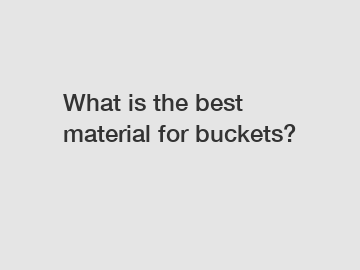Feb. 20, 2024
Packaging & Printing
When it comes to choosing the best material for buckets, there are several factors to consider. Buckets are commonly used in a variety of industries, including agriculture, construction, and manufacturing. The material of the bucket can significantly impact its performance, durability, and lifespan. In this blog post, we will explore the different materials commonly used for buckets and discuss the pros and cons of each.
One of the most popular materials for buckets is plastic. Plastic buckets are lightweight, affordable, and resistant to corrosion. They are also easy to clean and maintain, making them a popular choice for many industries. However, plastic buckets may not be as durable as other materials and can be prone to cracking or breaking under heavy loads. Additionally, plastic buckets may not be suitable for high-temperature applications, as they can melt or warp when exposed to heat.
Another commonly used material for buckets is metal, such as steel or aluminum. Metal buckets are known for their strength, durability, and resistance to wear and tear. They are often used in heavy-duty applications where high performance is essential. Metal buckets can withstand extreme temperatures, making them suitable for a wide range of environments. However, metal buckets can be heavier and more expensive than plastic buckets, making them less practical for some applications.

A third option for buckets is fiberglass. Fiberglass buckets are lightweight, durable, and resistant to corrosion. They are also non-conductive, making them a safe choice for electrical applications. Fiberglass buckets are often used in industries where strength and durability are essential, such as construction and utilities. However, fiberglass buckets may not be as cost-effective as plastic or metal buckets, and they can be prone to cracking or chipping under heavy loads.
In addition to plastic, metal, and fiberglass, buckets can also be made from wood. Wooden buckets are a traditional choice that is still used in some industries today. Wooden buckets are biodegradable, making them a sustainable choice for environmentally conscious businesses. However, wooden buckets may not be as durable or resistant to wear and tear as other materials, and they can be prone to rotting or warping when exposed to moisture.
So, what is the best material for buckets? The answer depends on the specific needs and requirements of your application. If you need a lightweight and affordable option, plastic buckets may be the best choice. If you require strength and durability, metal buckets may be the better option. For applications where corrosion resistance is essential, fiberglass buckets may be the ideal choice. And for those looking for a sustainable option, wooden buckets may be the best fit.
Ultimately, the best material for buckets will depend on a variety of factors, including the specific application, budget, and environmental considerations. When choosing a material for your buckets, be sure to consider the pros and cons of each option carefully. By selecting the right material for your buckets, you can ensure optimal performance, durability, and longevity for your equipment.
For more 1kg IML Plastic Container, 8oz Plastic Rectangular Yogurt Container Wholesale, ice cream containers with lids wholesaleinformation, please contact us. We will provide professional answers.
If you are interested in sending in a Guest Blogger Submission,welcome to write for us!
All Comments ( 0 )